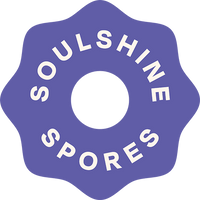Not All Lion’s Mane is Created Equal: What You Need to Know
Lion’s Mane mushroom has exploded in popularity in recent years, and for good reason. This unusual-looking fungus is celebrated for its potential to support memory, concentration, and overall cognitive health. But here’s something many people don’t know:
Not all Lion’s Mane is the same.
In fact, there are different species that often get lumped together under the name "Lion’s Mane" — and they’re not all created equal in terms of benefits or scientific backing.
The Real Deal: Hericium erinaceus
At Soulshine Spores, we use only Hericium erinaceus — the original and most studied species of Lion’s Mane mushroom. Recognisable by its shaggy, white, icicle-like appearance, this mushroom has been used in traditional Chinese, Japanese, and Korean medicine for centuries. Known for its nootropic (brain-boosting) potential, Hericium erinaceus contains unique compounds such as hericenones and erinacines, which are believed to stimulate the growth of brain cells and support nerve regeneration.
Modern scientific studies have linked this species to a range of benefits, including:
Improved memory and focus
Reduced symptoms of anxiety and depression
Enhanced nerve regeneration and neuroprotection
It’s this powerful combination of tradition and science that makes Hericium erinaceus the gold standard when it comes to Lion’s Mane supplements.
The Kiwi Cousin: Hericium novae-zealandiae
In New Zealand, you might come across a different mushroom marketed as Lion’s Mane: Hericium novae-zealandiae, or by its traditional Māori name, Pekepeke-kiore. While this native species is part of the same Hericium family and shares some visual similarities, it has a very different backstory.
Hericium novae-zealandiae does not have the same long history of medicinal use. Nor does it have the robust body of scientific research that backs Hericium erinaceus. Although it may hold some potential — and its cultural significance should not be overlooked — it's important to know that the benefits of this species are largely anecdotal at this stage.
In short: while it’s related, Pekepeke-kiore is not the same as the Lion’s Mane mushroom used in most of the world’s nootropic research.
Quality Matters: Fruiting Body vs. Mycelium
Another key factor to consider when choosing a Lion’s Mane product is which part of the mushroom is being used. Many supplements use the mycelium — the root-like network that grows underground or in a substrate like grain. While mycelium is easier and cheaper to produce, it often contains far fewer beneficial compounds than the actual mushroom itself.
That’s why we only use the fruiting body — the visible, above-ground part of the mushroom. This is where the highest concentration of active compounds is found. It’s also the part used in traditional medicine and most clinical studies.
So when we say our Lion’s Mane is potent, we mean it.
The Bottom Line
If you’re taking Lion’s Mane for its cognitive benefits, make sure you know what you’re getting. Look for products made from:
100% fruiting body
The correct species: Hericium erinaceus
Brands that are transparent about sourcing and extraction
Not all mushroom products live up to their promises. But with the right species, the right part of the mushroom, and the right processing methods, Lion’s Mane can be a powerful ally for brain health and mental clarity.
Check out our medicinal mushroom powder blends with Lion's Mane - Rise & Shine and Balance & Flow.

